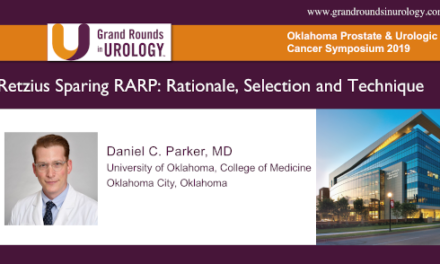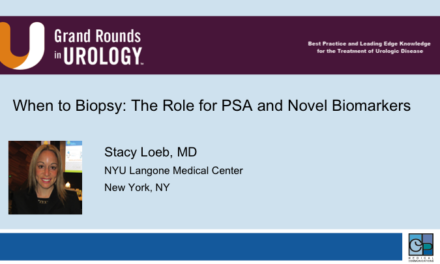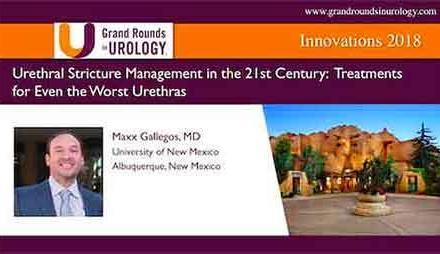Dr. Daniel P. Petrylak presented “Update on Radiopharmaceuticals: Choosing a Companion Drug to Radium-223” at the 27th annual International Prostate Cancer Update meeting on Thursday, January 26, 2017.
Keywords: prostate cancer, abiraterone, ALSYMPCA, bisphosphonates, chemotherapy, denosumab, enzalutamide, placebo, Radium-223
How to cite: Petrylak, Daniel P. “Update on Radiopharmaceuticals: Choosing a Companion Drug to Radium-223” January 26, 2017. Accessed Jan 2025. https://dev.grandroundsinurology.com/choosing-companion-drug-radium-223
Transcript
Update on Radiopharmaceuticals: Choosing a Companion Drug to Radium-223
I’m going to give you an update on radiopharmaceuticals, choosing a companion drug for Radium-223. So first I’d like to review some of the data with radium. These are my disclosures.
So we know that for bone targeted therapy there are a variety of different agents that are bone specific. We have beta emitters, which are strontium and samarium. As well know, these drugs do not improve survival, but they do palliate pain. The alpha emitters, radium-223. And then there are the osteoclast targeted agents, zoledronic acid and denosumab. But of course, we also have other agents as well that effect different portions of prostate cancer. The big difference, of course, with alpha and beta emitters has to do with DNA damage. As we know, an alpha particle consists of a helium nucleus. It does not penetrate a sheet of paper. It kills about 1 to 10 cells predominately by inhibiting double-stranded DNA breaks. The beta particles, it requires more energy to cause DNA hits. And it causes predominantly single-stranded DNA breaks. And so this is the reason why we think there’s such a difference in the activity. And, of course, there’s a difference in the radius of activity as well, which has implication for side effects.
So this is a cartoon that depicts bone marrow with a tumor that’s present. And, of course, there’s marrow and stroma that’s around that tumor. A beta particle ranges this area. It’s about 1 to 1,000 cell diameters, the activity of the radiation. And then the alpha particle is a much, much smaller area of activity, it’s about 2 to 10 cell diameters overall; and thus, normal marrow is not affected to the same degree as it would a beta particle.
The trial that led to the approval of radium-223 for prostate cancer was ALSYMPCA. As we know, this was a trial that had two different components, both docetaxel ineligible or refusal, patients as well as docetaxel experienced patients. Patients had to have symptomatic bone metastases, more than two lesions, no evidence of visceral metastases, and as I mentioned before, they had to be either post-docetaxel or unfit for docetaxel. They were stratified based upon alkaline phosphatase, bisphosphatase use and prior docetaxel, and then randomized to a maximum of 6 cycles of radium-223, plus best supportive care, versus best supportive care alone.
Now, it’s important to note that this best supportive care included adding bicalutamide, included adding estrogens, included external beam radiation therapy to hot spots which made them painful. So this is just not really pure radium arm, but would normally what somebody would do in the standard of care. It did not include the newer generation drugs such as abiraterone or enzalutamide, which we’ll talk about a little bit later.
This trial was what one would expect with randomization, very, very equally balanced. Median age was about 70. About half of patients had more than 20 lesions on bone scan, predominately ECOG 1 or better for the performance status. If you look at the hemoglobins, these are not terribly advanced. Hemoglobin median of 12.2. This is a known poor prognostic factor, LDH of 315, median PSA between 146 and 170. And about half of the patient were on bisphosphonates. About half of patients also had prior docetaxel treatment.
This is the combined survival curve for both the post-docetaxel and the docetaxel ineligible patients. The hazard ratio is 0.65, and the median survival was 14.9 months versus 11.3 months overall. If we break this up based upon prior chemotherapy, median survival of 4.64, the docetaxel naïve patients, and 3.1 for those patients who were docetaxel experienced. Not unexpected.
Now, if we start looking at skeletal-related events, as defined by Fred Sodd’s [phonetic] trial, we see that there’s a delay in the time to the first SRE. This giving radium compared to the placebo, it’s about a 6 month delay. And we start looking at the individual skeletal event related components the one that always strikes out is spinal cord compression, which to my knowledge is the only trial that shows a difference in, or improvement in rates of spinal cord compression. It makes, of course, since this a bone targeted agent.
A very well-tolerated drug. If we start looking at grade 3 and grade 4 adverse events, slightly higher in the placebo. That’s predominately due to pain events. Discontinuation due to adverse events only 17% of patients, and death due to AEs, 16% of patients.
The majority of patients did get all 6 injections, 63% of all patients, and 47% received all 6 placebo injections. Adverse events, these are, of course, related to hematologic events predominately. We do see grade 3 and grade 4 neutropenia, thrombocytopenia, but not anywhere near what you would expect samarium or strontium.
When we look at the prognostic subgroups that were looked at in this trial, alkaline phosphatase, use of bisphosphonates, docetaxel, ECOG performance test, all these, it’s shifted toward the left, towards radium.
So we’ve had many questions about whether you can safely give chemotherapy, and this has a lot, of course, important implications for therapeutic layering and how we sequence our drugs. And from ALSYMPCA is there any evidence that chemotherapy treatment is compromised by giving radium-223 upfront. And there was a subgroup analysis, or retrospective analysis looking at those patients who received radium. And of those patients, 90 of the 615 patients in the radium group were evaluated, and 54 of the 307 in the placebo group, and the most common chemo therapeutic agents that were administered were docetaxel, of course, mitoxantrone and cyclophosphamide. Very well balanced for age and also the different characteristics as far as overall extent of disease is concerned. Similar rates of bisphosphonate use, and also similar rates of median numbers of injections of study drug.
If we look at the platelets and the hemoglobin they seem to cross for those patients who were on the placebo arm and received chemotherapy, or those patients who received radium-223. It does seem to be a difference in the neutrophil counts, but there is no difference in febrile neutropenia between the two different arms. So I think that when we’re looking at therapeutic layering and sequencing it’s not really going to make a difference whether you give the radium before or afterwards. And, of course, there’s been no trial that’s been done looking at cabazitaxel in this situation.
So we talked regular skeletal-related events according to the Sodd definition. What about systematic skeletal-related events, which I think are a little bit more clinically significant. Oliver Sartaor went back and he looked at the data from ALSYMPCA and looked at rates of symptomatic skeletal events. About a third of the patients treated with radium-223 versus 38% of the placebo group had an event, but the time to the first event was longer in those patients who received radium by about 6 months overall. When you start looking at the components that he looked at of the symptomatic events, the reduction was seen and the need for radiation therapy as well as we pointed out before, the incidence of spinal cord compression, but there was no difference in pathological fractures or tumor-related orthopedic surgical events.
And then Dr. Nilsson has actually looked back at the data 1.5 years after treatment to see if there had been any of types of long-term side effects seen with radium. And I think the most important one, the one that we get most concerned about is the fact that these patients are exposed to an isotope, do they develop leukemia? There weren’t any reports of that, or mild dysplastic syndrome, or primary bone tumors. So again, I think that the long-term safety is being defined.
So what have we learned from ALSYMPCA? What haven’t we learned? Well, we’re improving survival, we’re improving symptomatic skeletal-related events or delaying it. We also have been able to give bisphosphates, external beam radiation therapy, and as mentioned before, the first generation hormonal agents with radium, but we didn’t look at abiraterone, we didn’t look at enzalutamide. Denosumab was not included in the entry criteria. And this has been I think a real frustration for a lot of clinician, the dose of radium is limited to 6 cycles by the FDA approval, so we really can’t give more than 6 cycles at this particular point. So can we give more than that? And I think I’m going to ask that question.
So, protocol 16506, I borrowed these slides from Oliver Sartor, looked at radium in patients who have had 6 cycles and then progressed, and were strictly eligible by homologic criteria. They were eligible to receive 6 more cycles of radium, and what they concluded was that radium could safely be given for another 6 cycles after the first 6 cycles.
What I think is very, very interesting is the pattern of progressions. And this actually leads us to think of how we can partner radium with other drugs. So this is the progression in bone. As one would expect, the progression in bone is not particularly, not at a high rate. More than 90% of patients did not progress in bone after the 6 cycles of radium, not surprising. Now, think back to ALSYMPCA as well, unfortunately, that trial did not do scans mid and after the third cycle. So again, this is sort of new territory. But what was very, very interesting was the progression of disease was dominant in soft tissue, which again leads us to think that we’d like to combine radium with drugs that target agents in soft tissue, such as hormonal agent, or potentially chemotherapeutic agents.
So this is modified from our friend Ken Pienta, looking at the way that we can think about prostate cancer. As we know, radium hits three different portions of the bone equilibrium with the tumor cell and the stroma. It affects the stroma, it affects the extracellular matrix, as well as the osteoblasts, and then, of course, it directly causes cytotoxicity of the tumor cells. This also lets antigens out, it could affect the immune system. And there are studies, which we’ll talk about later, which combine radium along with immune agents. And then, of course, we have agents that effect osteoclasts, such as bisphosphates and denosumab. And then our other targeted therapies, cytotoxic and androgen directed therapies, these all can be used to help improve overall response rates. Remember, as we’ve often pointed out at this meeting, Hodgkin’s disease is cured by four drugs, one approach, it’s very, very unlikely that one approach is going to cure prostate cancer. So that’s why we’ve got to look at this in terms of multiple areas of target.
So, we know that in patients who undergo bisphosphate treatment there can be an upregulation or a flare effect after giving bisphosphonates. And we again also see this with chemotherapy, we see this with abiraterone, we see this with enzalutamide. So, since we’re increasing the bone activity would it make sense to give radium in this particularly situation? That’s the interesting question. So if we look at the data from ALSYMPCA and look at bisphosphonates in terms of is an increased effect on survival in those patients who receive bisphosphonates versus those patients who didn’t, there isn’t any effect. But there is an effect on skeletal-related events. When you look at the data from the expanded access trial you see a very, very different pattern when you combine radium with denosumab. Those patients who received denosumab have a better survival than those patients who just simply received radium alone. So it’s radium plus denosumab versus radium. There does seem to be a better survival. Be careful, of course, this is only hypothesis generating. It’s not a randomized study.
The same thing is seen when you combine radium-223 with abiraterone. You see the same effect. There’s a better survival in those patients with have abiraterone plus radium, versus radium alone. Is that due to this issue about flaring the bone up and causing more targets for radium to hit, or is this because you’re affecting soft tissue with abiraterone? It’s not really clear, but again, something we need to study in the future.
So, where should we put radium in this continuum? Should it be right at the start of treatment, should it be at the induction of sclerosis, should it be at any other point in the course of disease progression, we really don’t have a good answer, nor do we have any good modeling for this, in fact. So again, the question is can we take advantage of this flare because we know that abiraterone and enzalutamide can cause flare-up of the bone lesions and this again may make this a more acceptable target for radium.
So, there are prospective trials that are underway. Radium plus abiraterone in a phase 3 study, as well as radium plus or minus, or enzalutamide plus or minus radium, so this may help to give us better answers to whether we can use this upfront. Remember, we’ve used these types of agents late in the disease because of strontium and samarium not demonstrating survival benefit. So it does really make sense to move this upfront in patients rather than waiting until they’re too sick.
This trial has completed accrual and I hope that we’ll be reading out some time this year. This is a randomized phase 3 trial that I led. Our primary endpoint was to look at radiographic progression-free survival to see if we were seeing any difference in scanning. So the control arm, so to speak, is radium-223 or group 1. Group 2 is radium plus abiraterone. And then group 3 was radium plus enzalutamide. So this trial has completed accrual and I hope that we’ll have an answer sometime within the next couple of—you know, a year or two as to what the progression-free survival rate is.
So, a couple of other things that have been seen in the expanded access trial study. The number of injections of radium, the survival seems to be better if you have more radium versus less radium. The only trouble is is that we see the same thing for the placebo arm. So does this mean that the patients will move on to more injections because they’re healthier, I’m not really sure at this particular point. But again, this leads us, we have to be very, very careful when we’re interpreting the biology of this disease. Also we see a better survival with the number of injections, but again, this may be related to biology as well as to the radium injection.
So, some of the predictors for receiving more cycles include higher numbers of anti-cancer treatments, ECOG performance status, as well as hemoglobin. So these, again, may be ways that we can predict who is going to do better with radium overall.
Now, it was noted before in the prior talks that there is this thing called abscopal effect. And what this is is we think that there is actually a release of cytokines when you radiate a patient. Actually, this is also seen with cryosurgery, it’s seen with a number of different local modalities where the distal tumor can respond where the primary tumor does not, or when the primary tumor is being treated, excuse me. So we can exploit this, and it’s thought to be due to an immune mechanism. And one of the things that we’ve seen with treatment such as Provenge is that there is an antigen spread. And there are antigens that are released when cells are dying. So there are two trials that are going on right now that are combing radium along with checkpoint inhibition therapy. Radium is being combined with atezolizumab. This is for patients who have bone disease, but they also have to have a soft-tissue lesion that needs to be biopsied, so it’s a little bit restrictive in the patient population, but nonetheless, it’s going to be answering some very, very interesting biological questions with this. Also pembrolizumab is being combined with radium-223 as well.
We’ve actually found, and my junior – -, Joe Kim is finally getting the paper written up, but we found that there’s upregulation of PD-L1 after radium administration. So this makes this a reasonable approach to go forth with. So you’re releasing antigens with radium and cell death, and then, of course, the immune therapy may actually improve things.
We also should be considering radium upfront. Can we add this earlier with docetaxel and antigen blockade and do even better? I’ve got some problems with this, and I’ll show you why, because I think it’s hard to give full dosages of both. And it may certainly be more reasonable to give this in a patient rather than docetaxel, because some men may not want to undergo that. But we really do need to do a prospective trial, because we don’t know what the long-term effects are of radium at 5 to 7 years in a patient with castrate when they eventually do become castration-resistant, so I think these are important questions.
So why am I a little bit sheepish about giving chemotherapy with radium-223? Because of the data Mike Morris has generate, where he did a phase 1 study where he gave radium and docetaxel at the same time. And, unfortunately, because of the myelosuppression that was seen, he had to wind up giving a lower dose of docetaxel. And the radium was also attenuated to a different schedule. It was given every 6 weeks rather than every 4. So he’s seen that there does seem to be some responses with the combination, radium-223, the PSA responses as well. But again, on the long-term, we’ve seen this with docetaxel, and we actually just published this this summer, that patients who receive more than 8 cycles of docetaxel have a significantly better survival than those who receive less. So I’m concerned about attenuating any drug, and I’m also concerned about attenuating the radium dose. So the question really is, and we do a randomized trial, which is going to be done with cooperative groups, should you add docetaxel to radium. And that was recently, I think, going from the steering committee.
So we need more studies with radium. I think it is best used in combination. I think that hormones plus osteoclast inhibitors do show some interesting patterns, particularly in the expanded access program. I don’t think that chemotherapy is the way to go. I think that immunotherapy is a very, very promising combination with radium. And then we need to move up the hormone sensitive disease and see if that will actually reduce our skeletal-related events, delay progression, and overall improve survival. Thank you for your attention.
ABOUT THE AUTHOR
Daniel P. Petrylak, MD, is currently Director of Genitourinary Oncology, Professor of Medicine and Urology, Co-Leader of Cancer Signaling Networks, and Co-Director of the Signal Transduction Program at Yale University Cancer Center in New Haven, Connecticut. He is a recognized international leader in the urology field. He earned his MD at Case Western Reserve University School of Medicine in Cleveland Ohio. He then went on to complete his Internal Medicine Residency at Albert Einstein College of Medicine/Jacobi Medical Center in the Bronx, and his fellowship at Memorial Sloan Kettering Cancer Center in New York.
Dr. Petrylak has served as principal investigator (PI) or co-PI on several SWOG clinical trials for genitourinary cancers. Most notably, he served as the PI for a randomized trial that led to the FDA approval of docetaxel in hormone refractory prostate cancer. He also helped to design and served as PI for the SPARC trial, an international registration trial evaluating satraplatin as a second-line therapy for hormone refractory prostate cancer.
Dr. Petrylak served on the program committees for the annual meetings of the American Urological Association from 2003-2011, and for the American Society of Clinical Oncology from 1995-1997 and 2001-2003. He also has served as a committee member for the Devices and Immunologicals section of the FDA. He has published extensively in the New England Journal of Medicine, Journal of Clinical Oncology, Journal of the National Cancer Institute, Cancer Research, and Clinical Cancer Research.





